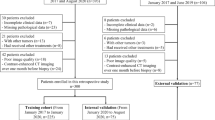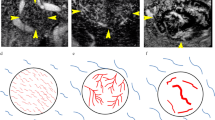Abstract
Objective
Although hepatocellular carcinoma (HCC) demonstrates characteristic hypervascularity, some HCCs have a hypovascular pattern on computed tomography (CT). Cytokeratin 19 (CK19) is a marker for the biliary phenotype reflecting a poor prognosis. We assessed the prognostic implications of tumor vascularity and its association with CK19 expression in HCC.
Methods
Patients that underwent surgical resection for HCC were included. Tumor vascularity was evaluated according to the arterial enhancement patterns on CT scans and CK19 expression was evaluated by using tissue microarray methods.
Results
One hundred and forty patients were included. Their median follow-up duration was 55.0 months, and 92 (65.7%) patients had tumor recurrence. Forty-five patients (30.6%) had hypovascular HCC at the time of diagnosis, and they showed a significantly higher CK19 expression rate (32.5% vs. 8.2%, P = 0.001) and earlier recurrence rate within 6 months (hazard ratio (HR), 2.301; P = 0.025) compared to the patients with hypervascular HCCs. Hypovascularity (HR, 1.694; P = 0.045) was an independent risk factor for short overall survival.
Conclusions
Hypovascular HCCs were associated with early recurrence and short overall survival, and CK19 was more frequently expressed in hypovascular HCC than in hypervascular tumors. Therefore, tumor vascularity on CT images might be utilized in determining the prognosis of patients with HCCs.



Similar content being viewed by others
References
Parkin DM, Bray F, Ferlay J, Pisani P (2005) Global cancer statistics, 2002. CA Cancer J Clin 55:74–108
Lau WY, Lai EC (2008) Hepatocellular carcinoma: current management and recent advances. Hepatobiliary Pancreat Dis Int 7:237–257
Poon RT, Fan ST, Lo CM, et al. (2000) Long-term prognosis after resection of hepatocellular carcinoma associated with hepatitis B-related cirrhosis. J Clin Oncol 18:1094–1101
Toyama T, Hiramatsu N, Yakushijin T, et al. (2008) A new prognostic system for hepatocellular carcinoma including recurrent cases: a study of 861 patients in a single institution. J Clin Gastroenterol 42:317–322
Sun M, Wu G, Li Y, et al. (2010) Expression profile reveals novel prognostic biomarkers in hepatocellular carcinoma. Front Biosci 2:829–840
Yang XR, Xu Y, Yu B, et al. (2010) High expression levels of putative hepatic stem/progenitor cell biomarkers related to tumour angiogenesis and poor prognosis of hepatocellular carcinoma. Gut 59:953–962
Kim CK, Lim JH, Park CK, et al. (2005) Neoangiogenesis and sinusoidal capillarization in hepatocellular carcinoma: correlation between dynamic CT and density of tumor microvessels. Radiology 237:529–534
Bolondi L, Gaiani S, Celli N, et al. (2005) Characterization of small nodules in cirrhosis by assessment of vascularity: the problem of hypovascular hepatocellular carcinoma. Hepatology 42:27–34
Takayasu K, Muramatsu Y, Mizuguchi Y, Ojima H (2007) CT Imaging of early hepatocellular carcinoma and the natural outcome of hypoattenuating nodular lesions in chronic liver disease. Oncology 72(suppl 1):83–91
Honda H, Tajima T, Taguchi K, et al. (2000) Recent developments in imaging diagnostics for HCC: CT arteriography and CT arterioportography evaluation of vascular changes in premalignant and malignant hepatic nodules. J Hepatobiliary Pancreat Surg 7:245–251
Yoon SH, Lee JM, So YH, et al. (2009) Multiphasic MDCT enhancement pattern of hepatocellular carcinoma smaller than 3 cm in diameter: tumor size and cellular differentiation. AJR Am J Roentgenol 193:W482–W489
Choi BI (2004) The current status of imaging diagnosis of hepatocellular carcinoma. Liver Transpl 10:S20–S25
Kim TK, Jang HJ, Wilson SR (2005) Imaging diagnosis of hepatocellular carcinoma with differentiation from other pathology. Clin Liver Dis 9:253–279
Kurokawa I, Urakawa Y, Senba Y, et al. (2006) Keratin profiles may differ between intraepidermal and intradermal invasive eccrine porocarcinoma. Oncol Rep 16:473–477
Wu PC, Fang JW, Lau VK, et al. (1996) Classification of hepatocellular carcinoma according to hepatocellular and biliary differentiation markers. Clinical and biological implications. Am J Pathol 149:1167–1175
Fanni D, Nemolato S, Ganga R, et al. (2009) Cytokeratin 20-positive hepatocellular carcinoma. Eur J Histochem 53:269–273
Yang XR, Xu Y, Shi GM, et al. (2008) Cytokeratin 10 and cytokeratin 19: predictive markers for poor prognosis in hepatocellular carcinoma patients after curative resection. Clin Cancer Res 14:3850–3859
Zhuang PY, Zhang JB, Zhu XD, et al. (2008) Two pathologic types of hepatocellular carcinoma with lymph node metastasis with distinct prognosis on the basis of CK19 expression in tumor. Cancer 112:2740–2748
Tralhao JG, Dagher I, Lino T, et al. (2007) Treatment of tumour recurrence after resection of hepatocellular carcinoma. Analysis of 97 consecutive patients. Eur J Surg Oncol 33:746–751
Vogl TJ, Trapp M, Schroeder H, et al. (2000) Transarterial chemoembolization for hepatocellular carcinoma: volumetric and morphologic CT criteria for assessment of prognosis and therapeutic success-results from a liver transplantation center. Radiology 214:349–357
Choi JI, Lee JM, Kim SH, et al. (2009) Differentiating focal eosinophilic necrosis of the liver from hepatic metastases using unenhanced and portal venous phase computed tomographic imagings: results of univariate and multivariate statistical analyses. J Comput Assist Tomogr 33:705–709
Gao Q, Qiu SJ, Fan J, et al. (2007) Intratumoral balance of regulatory and cytotoxic T cells is associated with prognosis of hepatocellular carcinoma after resection. J Clin Oncol 25:2586–2593
Uenishi T, Kubo S, Yamamoto T, et al. (2003) Cytokeratin 19 expression in hepatocellular carcinoma predicts early postoperative recurrence. Cancer Sci 94:851–857
Yeung YP, Lo CM, Liu CL, et al. (2005) Natural history of untreated nonsurgical hepatocellular carcinoma. Am J Gastroenterol 100:1995–2004
Tezuka M, Hayashi K, Kubota K, et al. (2007) Growth rate of locally recurrent hepatocellular carcinoma after transcatheter arterial chemoembolization: comparing the growth rate of locally recurrent tumor with that of primary hepatocellular carcinoma. Dig Dis Sci 52:783–788
Katyal S, Oliver JH, Peterson MS, et al. (2000) Prognostic significance of arterial phase CT for prediction of response to transcatheter arterial chemoembolization in unresectable hepatocellular carcinoma: a retrospective analysis. AJR 175:1665–1672
El-Assal ON, Yamanoi A, Soda Y, et al. (1998) Clinical significance of microvessel density and vascular endothelial growth factor expression in hepatocellular carcinoma and surrounding liver: possible involvement of vascular endothelial growth factor in the angiogenesis of cirrhotic liver. Hepatology 27:1554–1562
van Eyken P, Sciot R, van Damme B, et al. (1987) Keratin immunohistochemistry in normal human liver. Cytokeratin pattern of hepatocytes, bile ducts and acinar gradient. Virchows Arch A Pathol Anat Histopathol 412:63–72
Durnez A, Verslype C, Nevens F, et al. (2006) The clinicopathological and prognostic relevance of cytokeratin 7 and 19 expression in hepatocellular carcinoma. A possible progenitor cell origin. Histopathology 49:138–151
van Sprundel RG, van den Ingh TS, Desmet VJ, et al. (2010) Keratin 19 marks poor differentiation and a more aggressive behaviour in canine and human hepatocellular tumours. Comp Hepatol 9:4
Imamura H, Matsuyama Y, Tanaka E, et al. (2003) Risk factors contributing to early and late phase intrahepatic recurrence of hepatocellular carcinoma after hepatectomy. J Hepatol 38:200–207
Acknowledgements
This study was supported by the Korean Foundation of Liver Research (2009) and the Korea Healthcare Technology R&D Project, Ministry of Health and Welfare, Republic of Korea (A102065).
Conflict of interest
None.
Author information
Authors and Affiliations
Corresponding author
Rights and permissions
About this article
Cite this article
Chung, G.E., Lee, JH., Yoon, JH. et al. Prognostic implications of tumor vascularity and its relationship to cytokeratin 19 expression in patients with hepatocellular carcinoma. Abdom Imaging 37, 439–446 (2012). https://doi.org/10.1007/s00261-011-9756-3
Published:
Issue Date:
DOI: https://doi.org/10.1007/s00261-011-9756-3




